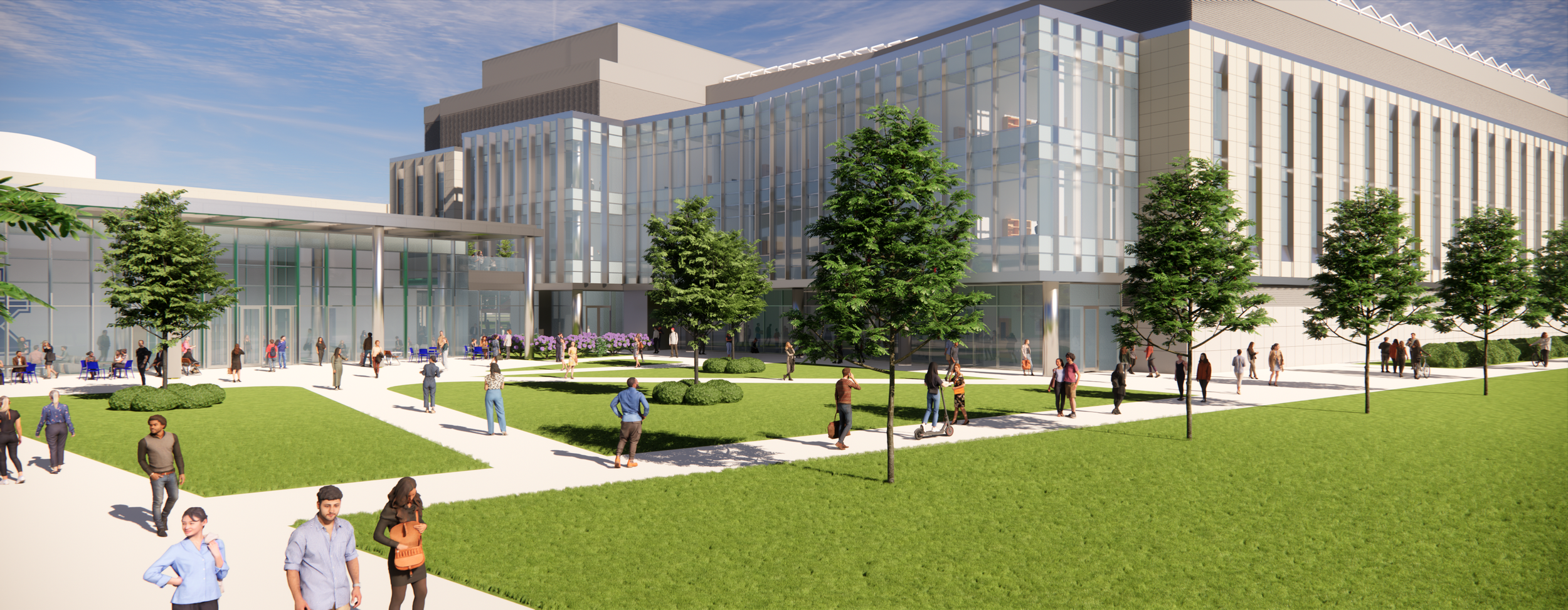University of Kentucky’s CAFE Expands with Modern Agricultural Research Hub
The University of Kentucky Agricultural Research Facility 1 for the Martin-Gatton College of Agriculture, Food and Environment (M-G CAFE) will serve as the college’s central research hub. Image: Courtesy of BHDP Architecture/Flad Architects
Chad Zuberbuhler, principal and planner for Flad Architects, is co-author of this piece.
The University of Kentucky (UK) recently broke ground on a state-of-the-art agricultural research building for the Martin-Gatton College of Agriculture, Food and Environment (M-G CAFE). This 269,000-square-foot facility will consolidate multiple departments and research functions currently spread across several older buildings and provide space for new research and increased capabilities.
Featuring advanced laboratories, rooftop greenhouses, teaching labs, and a versatile auditorium, the building is designed to foster collaborative and interdisciplinary research. This aligns with the university’s commitment to innovation in agricultural sciences and sustainable practices. “The research planned for the Agricultural Research Building will host cutting-edge research,” says James Matthews, M-G CAFE associate director for research. “Critically, this building will serve as a hub where our researchers can easily collaborate across disciplines, engage with agricultural industries, and work closely with the state’s producers with the goal of improving the quality of life for Kentuckians and boosting the Commonwealth’s economy.”
Advancing collaborative and multidisciplinary agricultural research
The new agricultural research building will house multiple M-G CAFE departments in a unique environment to encourage interdisciplinary collaboration and knowledge sharing. The facility combines various research components to allow for a seamless flow of activities—from plant growth in rooftop greenhouses to teaching labs on the first floor. This integrated facility will enable researchers to examine the entire lifecycle of agricultural products, significantly enhancing the depth and scope of their work.
The energy-efficient and environmentally-responsible design includes sustainable materials with low-volatile organic compound materials and recycled content, bio-mimicry elements, and natural daylighting. Image: Courtesy of BHDP Architecture/Flad Architects
Specialized infrastructures, including environmental chambers, biosafety labs, and advanced diagnostic facilities, are tailored to meet specific research needs. For instance, the vivarium, insectaries, and greenhouses form a comprehensive ecosystem, each operating in separate, precisely controlled environmental conditions.
The design of the building promotes collaboration and achieves efficiencies through shared resources. Faculty and principal investigators with similar research interests are co-located in the same lab, where shared spaces and resources can lead to innovative research outcomes. With this efficient use of space and resources, the cost savings were reinvested into amenities and upgraded equipment that were not otherwise within the project’s budget constraints. An example is the installation of grow lights in the greenhouses that emit 2,000 micromoles of light, more than tripling the standard 600 micromole output, allowing researchers to conduct corn and soybean experimentation that requires greater light intensity in the facility.
The convergence point for plant and animal research wings is the building’s central hub, housing elevators, conference rooms, and break rooms. The strategic placement of these common-use resources encourages spontaneous interactions among researchers from different disciplines, creating an environment where innovative ideas can emerge from chance encounters.
Incorporating sustainability
Sustainability is a core principle in the design and construction of the UK’s new agricultural research building, which is set to achieve LEED Silver certification. The building's design carefully balances the energy needs of a lab-intensive environment with stringent sustainability goals. Due to the high air exhaust requirements needed to maintain safety protocols using 100 percent outside air, the design team focused on optimizing the building’s thermal envelope to offset the energy consumption of these labs. Extensive envelope testing confirmed that the decision to use enhanced glazing and continuous insulation would allow for the installation of reduced-sized mechanical systems that can meet and exceed code requirements. This approach minimizes environmental impact while ensuring lab safety.
The building incorporates innovative HVAC strategies throughout. Areas adjacent to the labs or that have less stringent air requirements use transfer air from offices. This reduces overall air handler usage, contributing to the building’s energy efficiency and sustainability.
Besides energy efficiency, the project team prioritized selecting sustainable materials, including low-volatile organic compound materials and recycled content. The team chose environmentally responsible materials, even when such choices didn’t directly contribute to LEED points. For example, solid plastic was selected over phenolic plastic for lockers because it’s the better environmental choice. This commitment to “doing the right thing” is evident throughout the building.
A UK alumnus designed the building’s landscaping in partnership with the college’s Department of Horticulture. The plant selection focuses on native and non-invasive species, further enhancing the building’s sustainability profile. This approach supports local ecosystems and reflects a broader trend in sustainable landscaping practices.
The design of the facility promotes collaboration, innovation, and efficiency through shared resources and spaces. Image: Courtesy of BHDP Architecture/Flad Architects
Implementing biosecurity and spatial segregation
The new Martin-Gatton CAFE research building is divided into separate zones, with the south wing dedicated to animal research and the north wing focused on plant facilities. This design minimizes cross-contamination risks and optimizes research workflows. The building’s layout strategically stacks the specialized spaces with the vivarium on the first floor, wet and dry labs on the second floor, insectaries on the third floor, and rooftop greenhouses for enhanced efficiency and safety.
Dedicated environmental chambers for the insectaries provide precise control over humidity and temperature within ±0.5°C and ±5 percent relative humidity from the desired temperature and relative humidity percentage setpoints. Rather than using the typical approach of humidifiers and heaters, researchers can create optimal conditions for rearing separate insects, from honeybees to mosquitoes to ticks.
This layout enables a comprehensive “soil-to-table” research approach, allowing scientists to study plant growth, animal nutrition, and food production within a single, integrated facility. The diverse program setting includes specialized classrooms like the necropsy lab, further enhancing the building's research and educational capabilities.
Access control is managed through a multi-tiered security system to protect sensitive research areas while allowing public access to other spaces. Biosecurity measures include secure lab corridors, which control access to areas containing autoclaves that sterilize materials before they leave the controlled environment. This setup supports research capabilities while maintaining strict contamination control.
The facility features separate entrances and parking for different components, with a clear demarcation between public and restricted areas. Access to research floors, limited to upper levels, requires multiple card reader checkpoints, ensuring only authorized personnel can enter sensitive spaces.
Reinforcing community outreach
Lighting was designed to celebrate the accomplishments of the university from advances in research to athletic wins. Image: Courtesy of BHDP Architecture/Flad Architects
A versatile 230-seat auditorium is adaptable for both educational lectures and public events. Image: Courtesy of BHDP Architecture/Flad Architects
The M-G CAFE stakeholders sought to create a multifaceted facility beyond research, incorporating diverse teaching labs, classrooms, and public spaces. This approach aligns with the UK’s commitment to advancing agricultural research in a safe and controlled environment while providing resources to students and the local community. The building’s design seamlessly integrates its security features, allowing for versatile use of spaces like the 230-seat auditorium for public events while keeping research areas secure.
One of the strategic goals for the M-G CAFE is to serve the global community through the dissemination and application of agricultural knowledge. In support of this goal, the building will include several public community resources, including:
Insect museum: Operated by the Department of Entomology, this interactive space will serve as a vital community outreach tool, offering tours to elementary school students and other visitors. The museum will showcase live insect specimens, providing engaging learning opportunities to spark curiosity about entomology and biodiversity. This hands-on experience will help bridge the gap between academic research and public education, encouraging an early interest in agricultural and environmental sciences among young learners.
Equipped with cutting-edge laboratories, rooftop research greenhouses, classrooms, and office spaces for faculty, graduate students, and staff, the 269,000-square-foot facility will consolidate multiple departments and research functions, facilitating collaborative research endeavors. Image: Courtesy of BHDP Architecture/Flad Architects
Test kitchen: In addition to university researchers, the test kitchen will provide the opportunity for local businesses and restaurants to conduct testing. It’s designed for sensory testing of various foods, supporting academic studies and industry collaborations. Researchers can conduct experiments similar to commercial food development processes, such as refining the crunchiness of snack foods. By opening this resource to the community, the university encourages innovation in food science and provides valuable insights for local food producers and entrepreneurs.
Plant diagnostic lab: The lab will offer a crucial service to farmers and community members concerned about plant health. This regulated space will let individuals bring in plant samples exhibiting unusual characteristics or potential diseases for professional analysis. The lab will feature a sample processing area and diagnostic facilities equipped for microbiological and genetic testing. By providing accurate diagnoses of plant diseases, the lab will help maintain the health and productivity of crops throughout the region, directly supporting Kentucky's agricultural economy and food security.
Creating a home for agricultural innovation
The University of Kentucky’s new agricultural research building symbolizes a transformative era for the Martin-Gatton College of Agriculture, Food and Environment. This facility, part of a comprehensive revitalization that includes the Martin-Gatton Agricultural Sciences Building and Scovel Hall, reflects the university and the Commonwealth of Kentucky’s renewed commitment to advancing agricultural discovery and outreach. Moving beyond historically traditional images of agricultural sciences, the building reflects the university's commitment to advanced, diverse, and collaborative agricultural research that can address regional through global challenges.
Chad Zuberbuhler, co-author of this piece, is a principal and planner for Flad Architects. Chad works with project teams to support the development of facility design and program solutions, from the initial programming phase through construction documentation and construction administration. His responsibilities include program and planning of laboratories, administration, and mechanically intensive support areas; initial development and drawings of plans/elevations and facility process flows; and coordination of details and documentation. He knows that, above all, laboratory spaces need to function well, so his primary goal is to understand how each researcher best utilizes lab space and how the design team can help facilitate the client's research.







